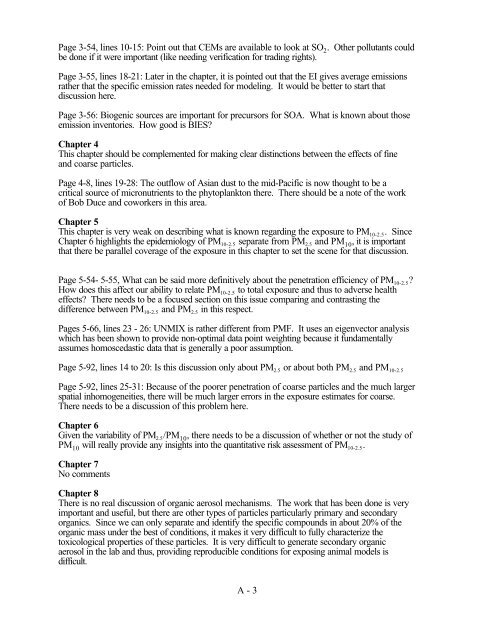Review of the Air Quality Criteria Document for Particulate Matter
Review of the Air Quality Criteria Document for Particulate Matter
Review of the Air Quality Criteria Document for Particulate Matter
- No tags were found...
You also want an ePaper? Increase the reach of your titles
YUMPU automatically turns print PDFs into web optimized ePapers that Google loves.
Page 3-54, lines 10-15: Point out that CEMs are available to look at SO 2 . O<strong>the</strong>r pollutants couldbe done if it were important (like needing verification <strong>for</strong> trading rights).Page 3-55, lines 18-21: Later in <strong>the</strong> chapter, it is pointed out that <strong>the</strong> EI gives average emissionsra<strong>the</strong>r that <strong>the</strong> specific emission rates needed <strong>for</strong> modeling. It would be better to start thatdiscussion here.Page 3-56: Biogenic sources are important <strong>for</strong> precursors <strong>for</strong> SOA. What is known about thoseemission inventories. How good is BIES?Chapter 4This chapter should be complemented <strong>for</strong> making clear distinctions between <strong>the</strong> effects <strong>of</strong> fineand coarse particles.Page 4-8, lines 19-28: The outflow <strong>of</strong> Asian dust to <strong>the</strong> mid-Pacific is now thought to be acritical source <strong>of</strong> micronutrients to <strong>the</strong> phytoplankton <strong>the</strong>re. There should be a note <strong>of</strong> <strong>the</strong> work<strong>of</strong> Bob Duce and coworkers in this area.Chapter 5This chapter is very weak on describing what is known regarding <strong>the</strong> exposure to PM 10-2.5 . SinceChapter 6 highlights <strong>the</strong> epidemiology <strong>of</strong> PM 10-2.5 separate from PM 2.5 and PM 10 , it is importantthat <strong>the</strong>re be parallel coverage <strong>of</strong> <strong>the</strong> exposure in this chapter to set <strong>the</strong> scene <strong>for</strong> that discussion.Page 5-54- 5-55, What can be said more definitively about <strong>the</strong> penetration efficiency <strong>of</strong> PM 10-2.5 ?How does this affect our ability to relate PM 10-2.5 to total exposure and thus to adverse heal<strong>the</strong>ffects? There needs to be a focused section on this issue comparing and contrasting <strong>the</strong>difference between PM 10-2.5 and PM 2.5 in this respect.Pages 5-66, lines 23 - 26: UNMIX is ra<strong>the</strong>r different from PMF. It uses an eigenvector analysiswhich has been shown to provide non-optimal data point weighting because it fundamentallyassumes homoscedastic data that is generally a poor assumption.Page 5-92, lines 14 to 20: Is this discussion only about PM 2.5 or about both PM 2.5 and PM 10-2.5Page 5-92, lines 25-31: Because <strong>of</strong> <strong>the</strong> poorer penetration <strong>of</strong> coarse particles and <strong>the</strong> much largerspatial inhomogeneities, <strong>the</strong>re will be much larger errors in <strong>the</strong> exposure estimates <strong>for</strong> coarse.There needs to be a discussion <strong>of</strong> this problem here.Chapter 6Given <strong>the</strong> variability <strong>of</strong> PM 2.5 /PM 10 , <strong>the</strong>re needs to be a discussion <strong>of</strong> whe<strong>the</strong>r or not <strong>the</strong> study <strong>of</strong>PM 10 will really provide any insights into <strong>the</strong> quantitative risk assessment <strong>of</strong> PM 10-2.5 .Chapter 7No commentsChapter 8There is no real discussion <strong>of</strong> organic aerosol mechanisms. The work that has been done is veryimportant and useful, but <strong>the</strong>re are o<strong>the</strong>r types <strong>of</strong> particles particularly primary and secondaryorganics. Since we can only separate and identify <strong>the</strong> specific compounds in about 20% <strong>of</strong> <strong>the</strong>organic mass under <strong>the</strong> best <strong>of</strong> conditions, it makes it very difficult to fully characterize <strong>the</strong>toxicological properties <strong>of</strong> <strong>the</strong>se particles. It is very difficult to generate secondary organicaerosol in <strong>the</strong> lab and thus, providing reproducible conditions <strong>for</strong> exposing animal models isdifficult.A - 3
















